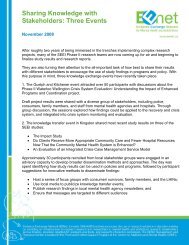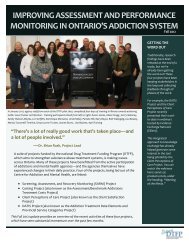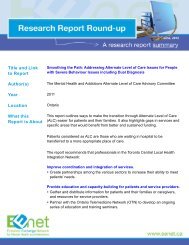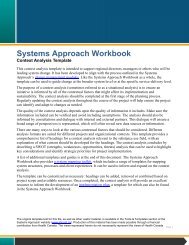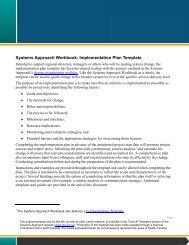5Centrally provided support (e.g., information resources, outreach advocacy), staff timededicated to this work, and clearly defined and monitored work plans may be helpful.Involving youth in public awareness presentations and campaigns was also suggested.o Many programs reported that they can access psychiatric expertise to support rapid intake oras part <strong>of</strong> the initial comprehensive assessment. However, small programs reported lowerlevels <strong>of</strong> implementation. Some programs identified access to psychiatry as a significantchallenge and put considerable time into developing and maintaining relationships withpsychiatrists. Suggestions for increasing access included changes in funding support andmechanisms for disbursement, and psychiatrist training in the EPI model. A regional rolewas identified, perhaps through mobile treatment teams. Telemedicine was used by someprograms although more <strong>of</strong>ten for the initial assessment than ongoing treatment. (Similarly,programs reported high rates <strong>of</strong> use <strong>of</strong> low dose antipsychotic medications when appropriate,but small and community programs reported more challenges related to medical monitoring.)o Primary care (PC) physicians are important partners in EPI delivery. They make referrals,monitor medication side effects, and provide physical health care. However only half <strong>of</strong>program sites reported that most <strong>of</strong> their clients were being followed by a PC physician.Accessing PC physicians can be time consuming for EPI staff and frustrating for clients.Small programs may also lack nursing support. Suggestions to improve physical healthmonitoring included home visits by team nurses, referring clients without a regular PCphysician to local clinics, educating clients about the need for health monitoring, and usinghealth tracking sheets or shared electronic health information to communicate with PCphysicians.o Psychosocial supports can help clients maintain or resume their usual roles within thecommunity. Many programs <strong>of</strong>fered or enabled access to illness management and dailyactivities support, but provision <strong>of</strong> other supports (e.g., education, work, recreation) waslower. Least frequently <strong>of</strong>fered was peer support. <strong>Program</strong>s reported that mainstreamsupports were <strong>of</strong>ten not appropriate or available, and, internally, they noted a lack <strong>of</strong>resources and staff time.o <strong>Program</strong>s reported high levels <strong>of</strong> activity to support family involvement. About half have adedicated family support worker and others distribute the role across several staff members.Time to engage (travel time, being available after hours) was a major challenge. Also,families may have their own mental health problems that need to be addressed. Greater use <strong>of</strong>technology (e.g., social networking sites, websites, E-mail, chat rooms) could be explored toengage with families.o EPI is designed to be a time-limited service and the Standards indicate a length <strong>of</strong> stay <strong>of</strong> upto 3 years. The main challenges to meeting this element included lack <strong>of</strong> appropriatealternatives and clients not wanting to leave or engage with other services. Allowing moreflexibility in client length <strong>of</strong> time in the program was raised. Step-down/transition options arebeing <strong>of</strong>fered successfully in some Ontario programs, with one program showing that gainsmade by clients during the first 2 years were maintained at 5 years when a lower intensitylevel <strong>of</strong> specialized intervention was <strong>of</strong>fered.
6<strong>Implementation</strong> Supportso Most sites were part <strong>of</strong> an EPI program network to support clinical care and/or non-clinicalfunctions such as training, resource development, and community outreach. Moreinformation is needed about how the networks function and their potential to enhancepractice among members, especially small program sites.o Some small programs reported challenges in accessing necessary expertise and managingtravel time. Telemedicine, travelling regional mobile teams and network partners can assistsmall programs to deliver care as required. More information is needed to understand whatsupports are received and what else could be <strong>of</strong>fered.o Most programs reported time challenges, especially for public education, referral networkdevelopment, and developing linkages with other services and supports. Efficiencies could beachieved if some tasks were taken on or supported locally, regionally, or provincially, suchas development <strong>of</strong> educational materials, outreach to referral sources, and outreach to otherpotential service collaborators (inpatient units, crisis services, vocational supports).o The EPI model is complex, combining a number <strong>of</strong> evidence-based practices. Availability <strong>of</strong>written protocols to support implementation <strong>of</strong> the various model elements was generallylow. However, use <strong>of</strong> tools to support more standardized care delivery (such as checklists,templates and assessment measures) was frequently suggested. These could be developed at aregional or provincial level. One network is already developing and sharing service protocolsamong its members. The Ontario Common Assessment <strong>of</strong> Need 1 may be helpful.o Accessing medical care (psychiatric and primary care) was a challenge. Suggested strategiesto facilitate access included funding support (e.g., sessional fees), medical staff training inEPI model, and greater use <strong>of</strong> mobile treatment teams and telemedicine.o Most programs reported being able to meet the response time after referral targets set out inthe Standards. However, a small minority reported keeping a waitlist and use <strong>of</strong> translation orinterpretation services was low, raising questions about EPI program accessibility to allOntarians in need.o Cost <strong>of</strong> medications was a noted barrier to using low dose anti-psychotic medications. Betterdrug coverage in benefit plans and easier application processes (e.g., related to OntarioDisability Support <strong>Program</strong> (ODSP) and Trillium) were suggested.o Many programs suggested increased use <strong>of</strong> social networking and youth friendly technologysuch as web, texting, e-mail. At present, policies in some organizations are not supportive <strong>of</strong>these approaches, especially hospital settings.1 Ontario Common Assessment <strong>of</strong> Need is a standardized client assessment being implemented in communitymental health programs in Ontario.



